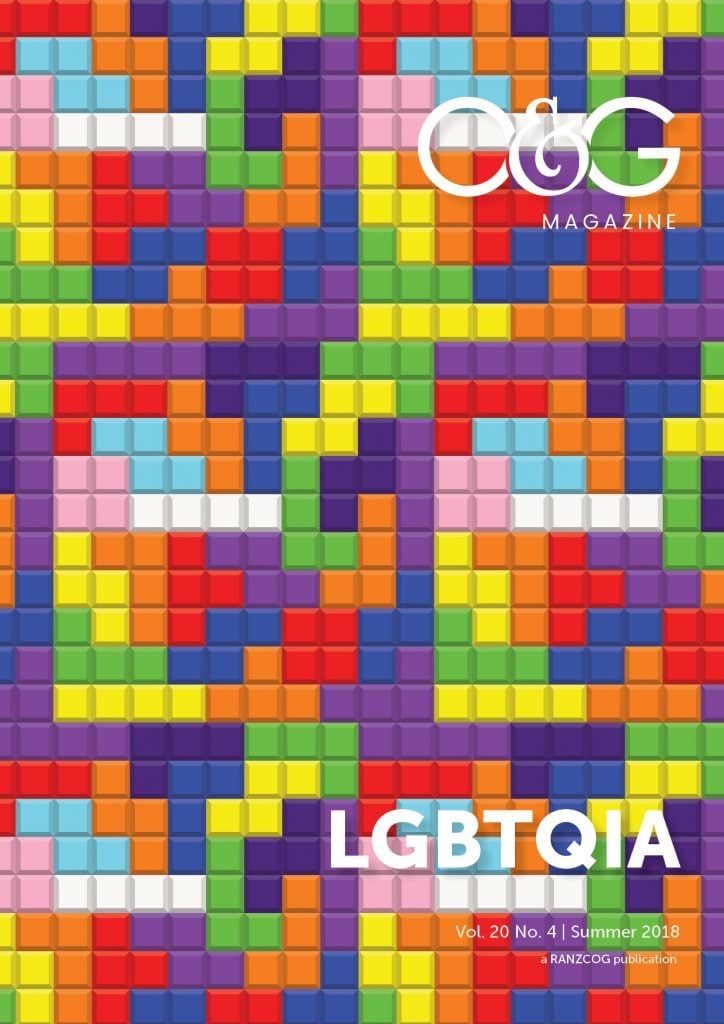In September 2017, in the lead-up to the postal vote on marriage equality in Australia, the RANZCOG Board released a statement in support of the initiative.1 The statement was controversial and some College members perceived it in political terms, prompting requests for RANZCOG to cease ‘taking sides in any public political or policy debate which does not have any direct bearing on its members’, as one colleague pointed out to me.
Marriage equality is now enshrined in law in Australia, as it was in New Zealand several years ago. From my perspective, the issue was never about politics, but about the adverse health effects of discrimination. As the Australian Government’s National Mental Health Commission put it, ‘discrimination of any kind, based on race, gender identity, relationship status, age, political opinion, disability or sexuality is detrimental to mental health’.2
Discrimination is unhealthy; there are potential adverse health consequences of our society’s treatment of disadvantaged groups.3 There exist clearly documented and significant disparities in access to, and receipt of, healthcare among transgender and gender non-conforming populations. Anything that limits the availability of appropriate and competent care, or fosters differential access to inclusive healthcare, perpetuates these disparities and can lead to significant morbidity and mortality.4
The Australian Human Rights Commission (AHRC) reports that, ‘due to a lack of comprehensive, publicly available data, it is difficult to estimate the total LGBTQIA population in Australia. Australians of diverse sexual orientation, sex or gender identity may account for up to 11 per cent of the Australian population’.5 This is a very large number of Australians and means that many of our patients and colleagues will identify as LGBTQIA.
While many gay, lesbian, bi, trans and intersex Australians and New Zealanders cope with systemic discrimination well, being subject to stigmatisation and discrimination is associated with a greater likelihood of depression, anxiety and emotional distress.6 People who do not conventionally ‘fit the mould’ of being male or female, commonly, are ‘subjected to ridicule, intimidation and even physical abuse’.7
The AHRC points out some important concerns: more than one-third of LGBTQIA Australians hide their sexuality or gender identity at work, at social events and when accessing services. In particular, young people are most likely to hide their sexuality or gender identity. The data also reveal that almost two-thirds of LGBTQIA young people report experiencing verbal, or even physical, homophobic abuse, including cyberbullying, graffiti, social exclusion and humiliation. Perhaps, unsurprisingly then, gay, lesbian, bisexual and transgender people are three times more likely to experience depression compared to the broader population. An Australian study reported that almost one in two young transgender Australians had attempted suicide.8
We all recognise that adolescents face many challenges in their transition to adulthood. Young adult LGBTQIA people face not only the typical challenges, but additional challenges related to the social stigma of their sexual orientation. For some, this stigma can induce psychosocial stress, leading to increased health risk behaviours and poorer health outcomes, such as substance use, eating disorders, suicidality, risky sexual behaviours, exposure to violence, victimisation and homelessness.9 Although many older LGBTQIA people are well, both physically and mentally, they face increased risks of certain health issues compared with the general population.10
These troubling statistics make LGBTQIA issues core College business, not matters of politics. We have an obligation to treat the LGBTQIA community in the same way that we call out the discrimination and racism that discourages young Aboriginal, Torres Strait Islander and Māori women from seeking antenatal care in pregnancy. In this issue of O&G Magazine, the editors have brought together a group of experts to shine light on the health of LGBTQIA Australians and New Zealanders. Remember that light is made up of all the colours of the rainbow.
Myself and the team at O&G Magazine would like to thank my friend and former work colleague, Dr Sarah van der Wal, for the enormous effort she has put into editing the LGBTQIA articles.
References
- RANZCOG Statement: www.ranzcog.edu.au/news/RANZCOG-Statement-Same-sex-marriage.
- National Mental Health Commission: www.mentalhealthcommission.gov.au/our-work/statement-on-marriage-equality.aspx.
- Rosenstreich G, Comfort J, Martin. Primary health care and equity: the case of lesbian, gay, bisexual, trans and intersex Australians. Aust J Primary Health 2011:17;302-308.
- Edmiston E, Donald C, Sattler A, et al. Opportunities and gaps in primary care preventative health services for transgender patients: a systemic review. Transgender Health 2016;1:216-230.
- AHRC: www.humanrights.gov.au/education/face-facts/face-facts-lesbian-gay-bisexual-trans-and-intersex-people.
- Beyondblue: www.beyondblue.org.au/who-does-it-affect/lesbian-gay-bi-trans-and-intersex-lgbti-people/the-impact-of-discrimination.
- AHRC: www.humanrights.gov.au/education/face-facts/face-facts-lesbian-gay-bisexual-trans-and-intersex-people.
- Strauss P, Cook A, Winter S, et al. (2017). Trans Pathways: the mental health experiences and care pathways of trans young people. Telethon Kids Institute, Perth, Australia.
- Coker T, Austin S, Schuster M. The health and healthcare of lesbian, gay, and bisexual adolescents. Annu Rev Public Health 2010;31:457-477.
- Hughes M. Health and wellbeing of lesbian, gay, bisexual, transgender and intersex people aged 50 years and over. Aust Health Rev 2018;42:146-151.






Leave a Reply